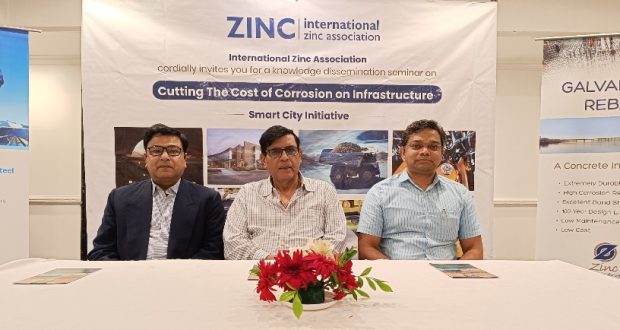TBB BUREAU
BHUBANESWAR, AUG 02, 2023
Highlighting the concerns over corrosion and its impact on infrastructure and public safety, the experts on Wednesday stressed on the need for a thorough corrosion protection mechanism that will not only ensure infrastructure longevity but also minimize economic and environmental damages.
 During a knowledge dissemination session on ‘Cutting the Cost of Corrosion on Infrastructure’ held on Wednesday in Bhubaneswar by the International Zinc Association the experts pressed on the urgency of protecting infrastructure of coastal cities from menace of corrosion. They examined the pressing concerns around corrosion damage on Infrastructure and found solutions.
During a knowledge dissemination session on ‘Cutting the Cost of Corrosion on Infrastructure’ held on Wednesday in Bhubaneswar by the International Zinc Association the experts pressed on the urgency of protecting infrastructure of coastal cities from menace of corrosion. They examined the pressing concerns around corrosion damage on Infrastructure and found solutions.
According to the CORCON Institute of Corrosion, the global cost of corrosion is $2.5 trillion per year, which equates to 3-4 percent of global GDP and about 4% of Indian GDP .Infrastructure failure due to corrosion has an impact on infrastructure, which has an impact on the economy. The International Zinc Association, the only industry association committed completely to the interests of zinc and its consumers.
Addressing the gathering, Dr. Rahul Sharma – Director (India), International Zinc Association said, “It is very important to reiterate the role of infrastructure in any country’s growth and development. International Zinc association, with the help of Hindustan Zinc – world’s largest zinc company has always focused on creating awareness around the implementation of zinc as an alternative. Through this platform we want to address the need for longevity and protection of countries’ premium infrastructures and call for the need to adopt durable and proven corrosion protection methods, like structure galvanisation.”
“We are extensively focusing on railway track treatments, In a bid to strengthen safety and performance, mainly in the corrosion-prone coastal regions, the Railway Board has given the go-ahead for using zinc-coated rails. Indian Railway need to invest on high-quality tracks made of galvanised steel and regular maintenance help prevent accidents and ensure the safe movement of trains. Well-maintained tracks minimize the risk of derailments, reducing the potential for injuries and loss of life among passengers and railway staff,” he added.
In most areas of the world, railroad tracks are replaced due to mechanical wear, but in India, they are subject to premature failure due to corrosion. This is a costly and preventable expense and IZA is working with the Ministry of Railways to demonstrate the effectiveness of zinc coatings for controlling corrosion. IZA is undertaking a demonstration trial using thermal sprayed zinc to prevent corrosion of the rail support webs. The trial has recently concluded and results showed significant improvement in rail life with thermal spraying, and it is expected the railways will move for system-wide adoption of thermal sprayed rails. In addition to thermal spray, India is undertaking a massive rail station refurbishment program and IZA continues its work with the Ministry to educate them on the importance of specifying galvanizing to protect and extend the life of the steel signs, poles and ancillary structures. IZA has also launched an education and outreach program aimed at non-railway projects including pedestrian and vehicle bridges, sign supports, safety barriers and fencing and steel culverts for drainage control. IZA has been continuously hosting technology seminars to specifying agencies, offering presentations and info exhibits at construction industry events, and launching a galvanized rebar focus group.
Amongst the many issues, one of the prolonged problems faced by the Indian railways is corrosion of Rail tracks as India has a long coastline. The open toilets in the trains along with animal and bird faeces add to the problem of Railway track corrosion. The ideal life of railway tracks should be 12 years but because of corrosion issues, rail tracks need to be replaced every two years, according to railway officials. Zinc Thermal spray of Rails resulted in reduced maintenance needs for railway tracks. The protective zinc coating acts as a long-term shield against corrosion, reducing the frequency of repairs and maintenance. This saves both time and resources for railway authorities, allowing them to focus on other critical maintenance tasks.
Commenting on this, Prof. P Dinakar, Professor, IIT Bhubaneswar; said, the control of steel corrosion in fresh projects is urgently required, while older, damaged structures must be repaired and adapted to comply with current norms. Through an enhancement in the steel’s quality or coatings on the concrete surface, coatings on the steel surface, etc., it is necessary to assure the functionality of these facilities. Galvanizing on the steel surface has shown promising results in minimizing corrosion among the numerous methods of controlling the corrosion of steel, according to many studies. The seminar was attended by senior officials from State PWD, IDCO, Indian Railways, Bhubaneswar Municipal Corporation, Smart City officials and some of the leading corporates and senior architects amongst others – who came together and debated on the pressing issues of corrosion.
 The Business Bytes
The Business Bytes
